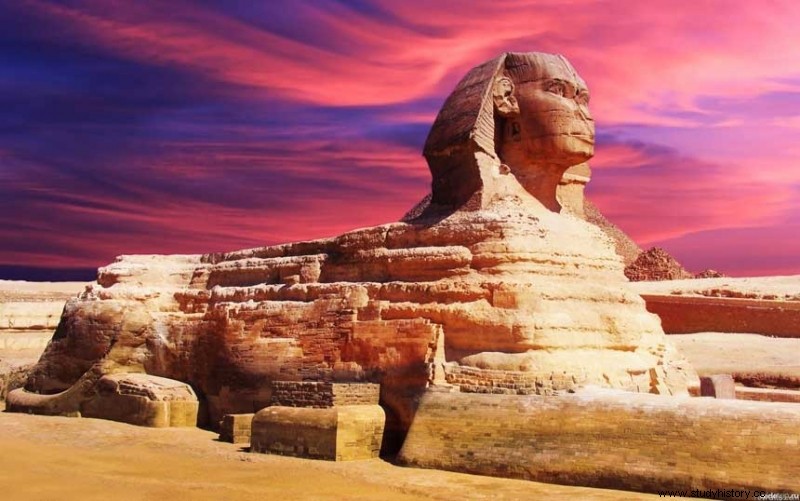If it were necessary to choose a letter of presentation of the pharaonic culture, the Sphinx would be among the first positions. It measures 73 meters in length and is almost 20 meters high. It is built from a natural outcrop of rock from an ancient stone quarry on the Gizeh plateau to which only stone blocks, some weighing up to 50 tons, had to be added to complete the leonine shape that we can see today. The study of its geology in the 1990s uncovered an angry controversy when it was discovered that the quarry was at least 5,000 to 7,000 years old, which meant that the lion was a kind of pre-pharaonic totem later reused in the time of the pyramids. . But today we will not cover this interesting topic. We will only keep the pharaonic part that we all know or, at least, we think so.

An ancient myth
The term "sphinx" is a Greek word that surely comes from the Egyptian expression «seshep anj «, «living image», one of the attributes of the god Atum, Creator and Lord of the Universe. The first testimonies that we conserve of her are in the IV dynasty, about 4,500 years ago. The fact that the Sphinx of Gizeh is located next to the funerary temple of Pharaoh Khafre (ca. 2500 BC) and at the foot of the road that leads to his pyramid, has traditionally led to the belief that it was this pharaoh, son of Cheops, who sculpted it. However, there are many doubts about it. Some of the questions that experts ask themselves are:what is he doing there in the middle of nowhere? Why did Khafre divert the pyramid road from him to reach the Sphinx? Does this mean that it was already there when Khafre took the throne?
Faceless Mystery
There really isn't a single text that identifies the Sphinx with Khafre. It is a "fact" that has always been copied from book to book and has spread from word of mouth, totally lacking in foundation. The presence on the Dream Stela of Tuthmosis IV (ca. 1400 BC) of Khafre's fragmented name, "Khafra", was one of the first conclusive "evidences". However, this is absolutely false, an urban legend that has spread like wildfire for more than a hundred years and has no justification. The stele was discovered in 1817 by the Italian Giovanni Battista Caviglia. We owe the first transcription of the text to Thomas Young, the English scientist who was a competitor of Jean François Champollion for deciphering hieroglyphs. In line 13 of the stela some of the ideograms that made up Khafre's cartouche do indeed appear, however, these do not appear surrounded, as would be logical, by a cartouche, the oval that always covers the names of kings. It could be Young's mistake, but I doubt it. He was the first to point out that the cartouches referred to the names of the kings. Had he seen it, the English would have pointed it out. The cartouche's absence was already noted by James Henry Breasted when he re-translated the stela nearly a century ago. In any case, Khafre's name wrapped in text gaps on the Dream Stela does not evidence his authorship. It could be a reference to the location of the monument next to the pyramid temple of this pharaoh. Unfortunately, line 13 of the stela has now disappeared, so there is currently not a single documentary evidence linking the Sphinx to Pharaoh Khafre.

Stylistic evidence
The so-called Stele of the Inventory or of the Daughter of Cheops, a document from the Saite Period (26th dynasty, 600 BC) refers to the Great Pyramid and the Sphinx. Although it does so indirectly, it implies that the Sphinx is really related to Pharaoh Cheops, the Khufu of the Egyptian texts, father of Khafre. It would not be crazy to say that the Sphinx is a portrait of Cheops, that is, half a century earlier than we had thought relating it to Khafre. This is what many Egyptologists believe, including the late Kurt Lange or currently Rainer Stadelmann, director for many years of the German Archaeological Institute in Cairo and one of the highest authorities in the world on the Old Kingdom and the pyramids. Actually, if we compare the face of the Sphinx with that of the diorite statue of Khafre in the Cairo Museum or with other figures from his reign, the stylistic contradictions are very great. For example, Khafre has a long and thin face, while that of the Sphinx is wide and almost square. The uraeus, the head cobra, are different. Khafre's eyebrows are arched, descending to the temples and framing slightly open eyes, while in the Sphinx the eyes are wide open and the eyebrows are smaller. But the most illuminating details are the lack of a beard on the Sphinx (the existing one is a later addition) and, above all, that the nemes headdress on the Sphinx is striped and pleated and on the statue of Khafre only the part that hangs over the chest. In short, they are sufficiently clear elements to separate the aesthetics of Khafre's time and bring it closer to that of his father Cheops, where although there is really very little real statuary, we can find some of the elements of the Sphinx. Other researchers such as the French Bassil Dobrev have pointed to Pharaoh Djedefra, Khafre's predecessor on the throne of Egypt and his brother, as the man represented in the Sphinx.
In any case, what they all say is that the Father of Terror still keeps many of his secrets. Some are classic, such as its geology, functionality and construction period. Others we create ourselves as we advance in the knowledge of it.
